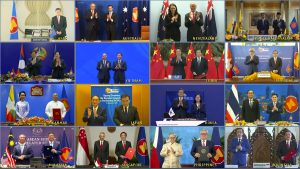After multiple stumbles, the Regional Comprehensive Economic Partnership (RCEP) was finally signed in November 2020. It has been a long journey to this point, starting about 8 years ago with the announcement that negotiations would commence. Ultimately, India did not participate, but with 15 signatories this is an enormous free trade agreement that represents roughly 30 percent of the world’s GDP and population.
With a rise in global protectionism during the COVID-19 crisis, the signing of the RCEP itself sends a significant political message from East Asia: a commitment to preserving the free and open economic order and trade systems. The agreement can also be interpreted as signifying a continuing faith in globalization as a path to national development. Finally, the timing of the signing – immediately after the United States presidential election – could be seen as an attempt by East Asia to show support for a free economic order irrespective of the outcome of the election.
RCEP is an experiment in “ASEAN-centered” economic integration, which seeks to build on the networks formed by the ASEAN+1 FTAs in the 2000s. The agreement does much to support the feasibility of the ASEAN-centered approach.
RCEP encompasses 15 fields, and contains an important milestone in the establishment of common rules and standards for economic activity. Agreements to reduce tariffs related to trade in goods in a wide range of fields are eye-catching, and will surely encourage progress in customs procedures, trade facilitation and rules of origin along with interregional trade.
Even more significant is that common rules were finally established in areas where they did not previously cover all ASEAN countries or did not involve countries such as China, specifically in competition, government procurement and electronic commerce. It is true that the Comprehensive and Progressive Agreement for Trans-Pacific Partnership (or CPTPP) has established common rules for fields that are not part of RCEP, including state-owned enterprises, labor, and the environment, but China and Korea are not part of the CPTPP, while only Singapore, Brunei, Malaysia, and Vietnam participate in that agreement from among ASEAN countries.
Of course, there are still some weaknesses in the RCEP provisions, even in the set of common rules and standards. For tariff reductions, there are reservations and conditions with each country. And while the agreement establishes that the cross-border transfer of data must not be blocked, there are no “legitimate public policy objectives” and the agreement allows for restrictions if there is a need for “protection of essential security interests.” It should be noted that, for all intents and purposes, the implementation of common rules is largely at the discretion of each country. This is unavoidable in light of the current diversity of economic standards among East Asian countries and other current conditions. Indeed, mandatory common rules that leave no room for discretion with each country are surely out of reach at present.
RCEP should be seen only as a part of ASEAN architecture, and it was not a Chinese-led negotiation. Unquestionably, however, China’s presence will increase through this framework. China confined COVID-19 relatively quickly and is already enjoying an economic recovery. And while the economies of East Asian have been rocked by COVID-19, trade between China and ASEAN countries has in fact increased, as has China’s investments in ASEAN. Construction of the China-Laos Railway, a centerpiece of the Belt and Road Initiative in Southeast Asia, is progressing smoothly after a temporary halt.
Most importantly, China is taking part in an experiment that is seeing the creation of common rules among East Asian countries, including ASEAN member states. China’s participation in RCEP shows that Beijing itself is willing to be bound by common rules and that it understands that greater transparency is to its benefit. This is surely as significant as China’s joining the WTO in 2001. Even if the RCEP does regulate its future economic activity in the short-term, China sees long-term significance in following regional common rules.
China’s economic policies have often been accused of deviating from global standards, with a closed domestic market and poor transparency. Now, though, it seems that it is ready to accept regional rules. This may very well give China a greater presence and influence on the future regional and international order. Chinese President Xi Jinping has even touted China’s possible participation in the TPP, perhaps as a tactic to block a U.S. return to the TPP fold. But it could also be seen as underscoring China’s political willingness to accept common economic rules in the Asia Pacific region.
At any rate, a major implication of RCEP is that it offers a foundation to promote a deepening of east Asian regional unification. The fact that the relative importance of the Chinese economy would grow in east Asia was inevitable from the start. As such, it can be said that paving the way for regional unification by having the Chinese economy placed under regional common rules is better than the alternative. For the other participants, RCEP is a framework that allows China to impose common rules while also maintaining a certain degree of closeness in their relationships with the economic giant.
As other countries in the region grapple with the fallout from the U.S.-China conflict, RCEP gives them an important tool for pursuing both their own economic prosperity and stable relations. That ensures that the bloc will have a major impact on the future Asian order.
OBA Mie is a professor at Kanagawa University.

































